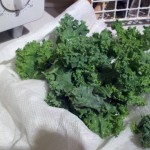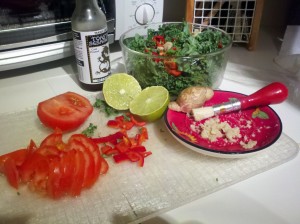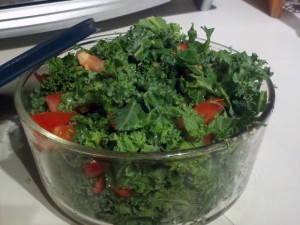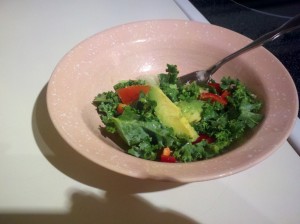Healthy Tips from the Road #1
Background: When I am on the road for business I tend not to eat in restaurants – just a current personal preference and no complex reason. My go-to place is usually a local or national health food store, where I might pick up a soup and salad or a hot dish (the latter only if I can eat it on site and if it still looks ‘fresh’). Keeping it “raw” means I am getting the most from the nutrients, but there are times when a salad just doesn’t seem sufficient.
Today’s tip relates to Kale – a leafy green vegetable known for its high nutritional value. Kale can be found in many shades of green (and even white and purple) and in a variety of leaf types. See More on what Kale is at bottom of the page for types and how to select kale.
Kale is a nutritional standout in three basic areas: (1) antioxidant and anti-inflammatory nutrients, (2) much-needed macronutrients (in which the average U.S. adult is currently deficient), and (3) cancer-preventive nutrients called glucosinolates. Details of Kale’s Nutrients (More on Kale’s Properties) are at bottom of the page.
Recently, I visited Mother’s Market (I have only seen them in Orange County, CA), and the deli had a number of raw offerings including a Kale salad. Kale has become the ‘vegetable of the year’ – popping up everywhere over the past year or so. I know how healthy kale is for one – however, I have always had a love-hate relationship with the vegetable; I found it tough to digest when lightly steamed and really icky looking when fully cooked, to say nothing of how it looks the next day if I have leftovers..….!
I bought the raw kale salad and I was hooked! It was delicious and I thoroughly enjoyed it – and it was filling. Needless to say this particular salad was not easy to find outside of this store. The national health-food chain had similar salads in some of their delis, but the ingredients included items I need to avoid. So what to do?
Well I have figured out my own recipe (very flexible in terms of changing out ingredients), and I will share it here because it has been great for the following reasons:
- It is raw! It has kale! It is healthy!
- My recipe makes it tasty. (OK that is my opinion)
- I can even make it in the hotel and put it in the refrigerator. (I always make sure I have a refrigerator and I usually travel with a ‘tupperware-type’ container , or at worst buy one, and a knife in my checked luggage, or at worst hack away with the plastic ones)
- It lasts a couple of days at least in the refrigerator without looking soggy and wilted – which is not true for many lettuce salads
- I can make enough for a couple of days (on the road or when I am home) and take it for lunch or eat it with dinner.
- Did I mention “filling”?
The Ingredients – all organic where possible, and note that having more or less of any ingredient is no issue:
- 10-12 kale leaves rinsed – I select the curly looking type. It just works better
- 1 Medium tomato
- 1 Small red pepper (Bell or other variety that is not “hot”). Summer is a great time for varieties of peppers
- Ginger root– about 3 x 2 inches; more or less makes no difference. Pickled ginger works as well.
- 1 Lemon for juice
- Olive oil or toasted sesame oil – about 3 – 4 teaspoons (more if you prefer)
- Sliced almonds – to sprinkle. About ¼ cup or less. Can use walnut pieces instead of Almonds.
Process:
- Cut the leafy part of the kale away from the thick part of the stalk. Discard the stalk.
- Take about ½ the leaves together and slice them (about ½ inch slices). Then turn this bunch of leaves 90 degrees and repeat. Then do the rest of the leaves in the same manner. You end up with bite size ‘chunks’
- Cut the tomato in half then cut slices (not thin), turn 90 degrees and cut slices again
- Cut the pepper into chunks
- Cut the ginger into chunks or grate. I have included photos for interest or assistance so you can see what my ‘chunks’ look like and what the kale I use looks like.
- Layer ingredients into a container. Halfway through the layering squeeze half the lemon and drizzle half the oil. Finish layering and squeeze rest of lemon and rest of oil.
- Feel free to sprinkle a little salt and pepper. I don’t but that is personal taste.
- Seal with lid and put in refrigerator. Eat at will!
Suggestions for garnishes to add when you eat:
- Slices of Avocado
- Crumbled goat cheese
- Arugula
- Currents or dried cranberries
- Diced Persian cucumber
As you can see, your imagination is all you need to make this a different dish each time.
Appendix Notes:
- 1. More on What Kale is:
Kale is a leafy green vegetable that belongs to the Brassica family, a group of vegetables including cabbage, collards, and Brussels sprouts that have gained recent widespread attention due to their health-promoting, sulfur-containing phytonutrients. It is easy to grow and can grow in colder temperatures where a light frost will produce especially sweet kale leaves. There are several varieties of kale; these include curly kale, ornamental kale, and dinosaur (or lLcinato or Tuscan) kale, all of which differ in taste, texture, and appearance. The scientific name for kale is Brassica oleracea.
Curly kale has ruffled leaves and a fibrous stalk and is usually deep green in color. It has a lively pungent flavor with delicious bitter peppery qualities.
Ornamental kale is a more recently cultivated species that is oftentimes referred to as salad savoy. Its leaves may either be green, white, or purple and its stalks coalesce to form a loosely knit head. Ornamental kale has a more mellow flavor and tender texture.
Dinosaur kale is the common name for the kale variety known as Lacinato or Tuscan kale. It features dark blue-green leaves that have an embossed texture. It has a slightly sweeter and more delicate taste than curly kale.
How to Select and Store
Look for kale with firm, deeply colored leaves and moist hardy stems. Kale should be displayed in a cool environment since warm temperatures will cause it to wilt and will negatively affect its flavor. The leaves should look fresh, be unwilted, and be free from signs of browning, yellowing, and small holes. Choose kale with smaller-sized leaves since these will be more tender and have a milder flavor than those with larger leaves. Kale is available throughout the year, although it is more widely available, and at its peak, from the middle of winter through the beginning of spring.
To store, place kale in a plastic storage bag removing as much of the air from the bag as possible. Store in the refrigerator where it will keep for 5 days. The longer it is stored, the more bitter its flavor becomes. Do not wash kale before storing because exposure to water encourages spoilage.
- 2. More on Kale’s Properties:
Antioxidant and Anti-inflammatory Nutrients
Kale’s antioxidants are both traditional as well as recently discovered.
In addition to conventional antioxidants like vitamin C, beta-carotene, and manganese, kale also provides us with at least 45 different recently discovered flavonoids, including kaempferol and quercetin. Many of the flavonoids in kale are also now known to function not only as antioxidants, but also as anti-inflammatory compounds.
Fiber and Anti-Inflammatory Omega-3 Fatty Acids
Fiber and omega-3s are two macronutrients largely deficient in the U.S. diet and provided by kale in impressive amounts. It only takes 200 calories’ worth of kale to provide 15 grams of fiber – substantially more than the average U.S. adult gets in an entire day after a diet of 2,000 calories. And while kale is not as concentrated in omega-3s as some of the other cruciferous vegetables – and certainly not in the same category as walnuts or salmon – it still provides us with a significant amount of alpha-linolenic acid (ALA), the basic building block for all omega-3 fats. From less than 100 calories’ worth of kale, we can get 25-35% of the National Academy of Sciences’ public health recommendation for ALA.
Kale and its Cancer-Preventing Phytonutrients
Kale’s special mix of cancer-preventing glucosinolates has been the hottest area of research on this cruciferous vegetable. Kale is an especially rich source of glucosinolates, and once kale is eaten and digested, these glucosinolates can be converted by the body into cancer preventive compounds. Some of this conversion process can also take place in the food itself, prior to consumption.
Also worth noting in kale’s nutritional profile is its vitamin K content. Kale contains nearly twice the amount of vitamin K as most of its fellow cruciferous vegetables.
In addition to the above-cited nutrients, according to our Food Rating System, kale is an excellent source of vitamin A (in the form of carotenoids), vitamin C, and manganese; a very good source of copper, tryptophan, calcium, vitamin B6, and potassium; and a good source of iron, magnesium, vitamin E, vitamin B2, protein, vitamin B1, folate, phosphorous, and vitamin B3.
Source for details on kale: whfoods.org






10 Responses to “Healthy Tips from the Road #1”